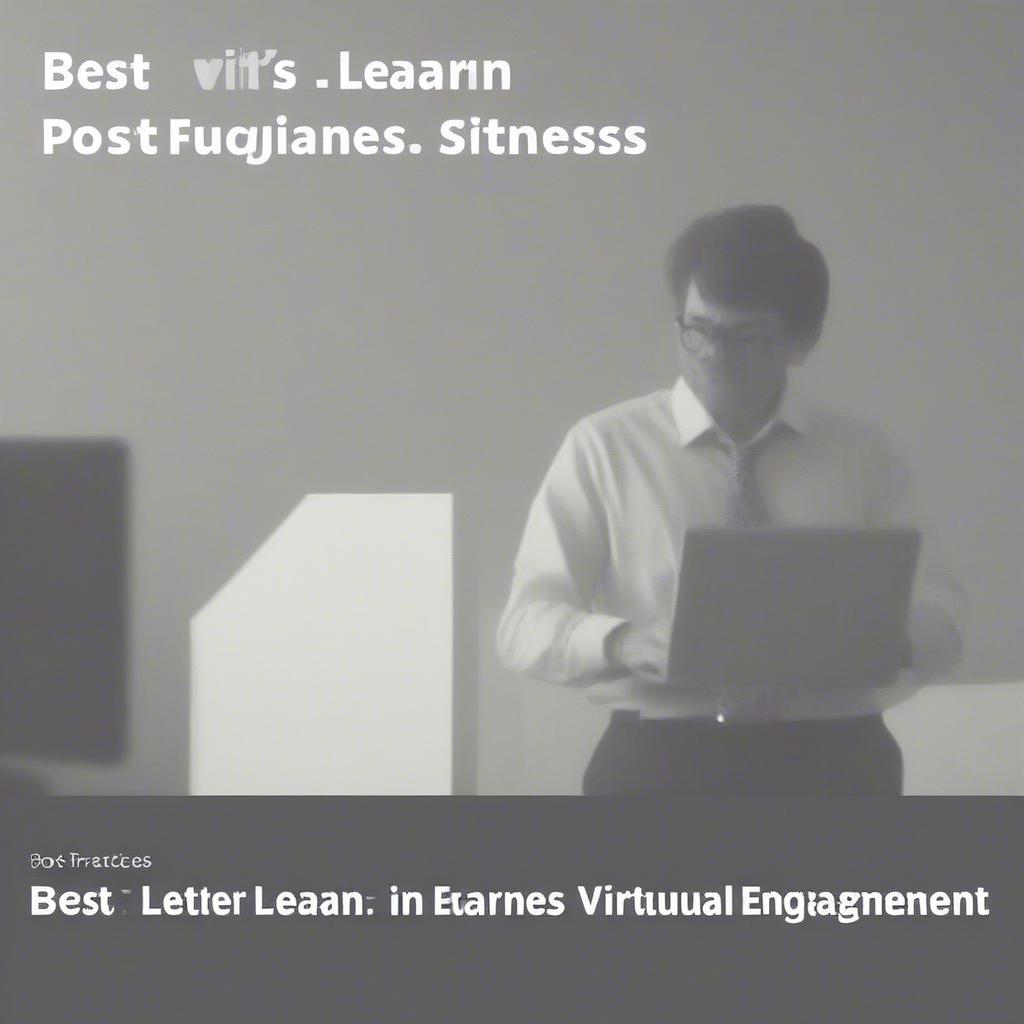
Virtual events have exploded in popularity, becoming a vital tool for businesses to connect with audiences, generate leads, and build brand awareness. But hosting the event is only half the battle. Post-virtual event engagement is crucial for maximizing your return on investment and ensuring your audience remembers you long after the virtual stage goes dark. Without a solid event planning strategy for the aftermath, you risk letting valuable momentum slip away. This comprehensive guide will explore the best engagement practices to transform attendees into loyal customers, brand advocates, and repeat participants.
1. Why Post-Virtual Event Engagement Matters: Beyond the Broadcast
Post-virtual event engagement isn’t an afterthought; it’s an integral part of a successful event planning strategy. It’s the bridge between fleeting interest and lasting impact. Let’s break down why it’s so important:
1.1. Extending the Event’s Lifespan
- What: Post-virtual event engagement extends the event’s lifespan by providing continued access to content and opportunities for interaction.
- Why: Events, especially virtual ones, can feel fleeting. By providing access to recordings, resources, and ongoing conversations, you keep the event alive long after the closing remarks.
- How: Offer on-demand access to session recordings, create dedicated online communities, and host follow-up webinars or Q&A sessions.
1.2. Nurturing Leads and Driving Conversions
- What: Engaging with attendees after the event provides opportunities to nurture leads and drive conversions.
- Why: Attendees who actively participated are often highly qualified leads. Post-virtual event follow-up allows you to personalize your messaging and guide them further down the sales funnel.
- How: Segment attendees based on their engagement levels, send targeted email campaigns, and offer exclusive discounts or promotions.
1.3. Gathering Valuable Feedback and Insights
- What: Post-virtual event engagement provides a platform to gather valuable feedback and insights from attendees.
- Why: Understanding what attendees liked, disliked, and found most valuable helps you improve future events and tailor your content to better meet their needs.
- How: Send post-event surveys, encourage social media comments, and monitor online discussions to gather feedback.
1.4. Building a Stronger Community
- What: Post-virtual event engagement fosters a stronger sense of community among attendees.
- Why: Shared experiences create connections. By facilitating ongoing conversations and interactions, you transform attendees into a community of like-minded individuals.
- How: Create dedicated online forums, host regular community calls, and encourage attendees to connect with each other on social media.
1.5. Amplifying Your Brand Message
- What: Engaging with attendees after the event helps amplify your brand message.
- Why: Satisfied attendees are more likely to share their positive experiences with others, expanding your reach and building brand advocacy.
- How: Encourage attendees to share their takeaways on social media, provide them with branded content to share, and offer incentives for referrals.
2. The Immediate Aftermath: First 24-48 Hours (Critical Window)
The first 24-48 hours after your virtual event are a critical window for capturing momentum and maximizing engagement. Here’s what you need to do:
2.1. Thank You Email: Personalized and Prompt
- What: Send a personalized thank-you email to all attendees within 24 hours.
- Why: A prompt thank-you shows appreciation and reinforces your brand’s commitment to attendee experience. Personalization makes the email feel genuine and less like a generic blast.
- How:
- Use merge fields to personalize the email with the attendee’s name and company.
- Reference specific sessions they attended or interactions they had.
- Include a link to the event recordings and any relevant resources.
- Express sincere gratitude for their participation.
-
Example Template: Subject: Thank you for joining us at [Event Name]!
Hi [Attendee Name],
Thank you so much for attending [Event Name]! We truly appreciate you taking the time to join us.
We hope you found the sessions informative and engaging, especially [mention a specific session they attended, e.g., “John Smith’s presentation on X”].
As promised, you can find the recordings and resources from the event here: [Link]
We value your feedback. Please take a few minutes to complete our post-event survey: [Link]
Thanks again for being a part of [Event Name]!
Sincerely,
The [Your Company Name] Team
2.2. Share Event Highlights on Social Media
- What: Share event highlights, key takeaways, and memorable moments on social media platforms.
- Why: Social media is a powerful tool for extending the event’s reach and showcasing its value to a wider audience.
- How:
- Create short video clips of key sessions or speaker quotes.
- Share attendee testimonials and positive feedback.
- Use the event hashtag to amplify your message and track mentions.
- Run contests or giveaways to encourage engagement.
2.3. Make Recordings and Resources Available
- What: Make event recordings, presentations, and other resources readily available to attendees.
- Why: Providing on-demand access to content allows attendees to revisit key takeaways and share them with colleagues.
- How:
- Upload recordings to a dedicated platform (e.g., Vimeo, YouTube).
- Organize resources in a central location (e.g., a shared Google Drive folder, a dedicated webpage).
- Clearly communicate how attendees can access the content.
2.4. Send a Quick Poll or Survey (Short and Sweet)
- What: Send a short poll or survey to gather initial feedback on the event.
- Why: Gathering immediate feedback helps you gauge attendee satisfaction and identify areas for improvement. Keeping it short increases the likelihood of participation.
- How:
- Use a simple survey tool like SurveyMonkey or Google Forms.
- Focus on a few key questions (e.g., overall satisfaction, most valuable session, areas for improvement).
- Keep the survey concise and easy to complete.
- Example Questions:
- On a scale of 1 to 5, how satisfied were you with the event overall?
- Which session did you find the most valuable?
- What is one thing we could improve for future events?
3. Weeks Following the Event: Sustaining Engagement and Building Relationships
Event planning that includes a long-term post-virtual event engagement strategy is crucial. The weeks following the event are your opportunity to nurture leads, build relationships, and solidify your brand’s presence.
3.1. Targeted Email Campaigns: Segmented and Personalized
- What: Develop targeted email campaigns based on attendee engagement levels and interests.
- Why: Personalization is key to driving conversions and building lasting relationships.
- How:
- Segment Attendees: Categorize attendees based on their registration information, session attendance, survey responses, and other engagement metrics.
- Tailor Messaging: Craft emails that address the specific needs and interests of each segment.
- Offer Valuable Content: Provide relevant resources, case studies, and blog posts to further educate and engage your audience.
- Include a Clear Call to Action: Guide attendees towards the next step in the sales funnel (e.g., schedule a demo, request a quote, download a resource).
- Example Segments and Email Content:
- Highly Engaged Attendees: Offer exclusive content, invitations to webinars, and personalized product recommendations.
- Attendees Interested in Specific Topics: Send relevant articles, whitepapers, and case studies related to their areas of interest.
- Attendees Who Didn’t Attend Specific Sessions: Provide recordings of the sessions they missed and offer opportunities to learn more.
3.2. Create an Online Community (Forum, Group, Slack Channel)
- What: Create a dedicated online community where attendees can connect with each other, share ideas, and continue the conversation.
- Why: An online community fosters a sense of belonging and provides a platform for ongoing engagement.
- How:
- Choose a Platform: Select a platform that aligns with your audience’s preferences and your brand’s overall strategy (e.g., a dedicated forum, a private Facebook group, a Slack channel).
- Set Clear Guidelines: Establish clear rules of engagement to ensure a positive and productive community environment.
- Moderate Actively: Regularly monitor the community to answer questions, facilitate discussions, and address any concerns.
- Provide Valuable Content: Share relevant articles, industry news, and exclusive content to keep the community engaged.
- Encourage Participation: Host regular Q&A sessions, run contests, and offer incentives for participation.
3.3. Host Follow-Up Webinars or Q&A Sessions
- What: Host follow-up webinars or Q&A sessions to delve deeper into specific topics covered at the event.
- Why: Follow-up webinars provide an opportunity to answer lingering questions, address specific challenges, and further educate your audience.
- How:
- Choose Relevant Topics: Select topics that are based on attendee feedback and areas of high interest.
- Promote Effectively: Promote the webinar through email, social media, and your online community.
- Engage the Audience: Encourage attendees to ask questions and participate in the discussion.
- Record the Session: Make the recording available to those who couldn’t attend live.
3.4. Share Attendee Success Stories and Testimonials
- What: Showcase attendee success stories and testimonials to demonstrate the value of your event and your brand.
- Why: Social proof is a powerful motivator. Sharing real-world examples of how your event has helped others can inspire others to take action.
- How:
- Gather Testimonials: Reach out to attendees and ask them to share their experiences.
- Create Case Studies: Develop detailed case studies that highlight specific challenges attendees faced and how your event helped them overcome those challenges.
- Share on Social Media: Post success stories and testimonials on your social media platforms.
- Feature on Your Website: Dedicate a section of your website to showcasing attendee success stories.
3.5. Personalized Follow-Up Calls (Especially for High-Value Leads)
- What: Make personalized follow-up calls to high-value leads to further qualify them and explore potential opportunities.
- Why: A personal phone call shows a higher level of interest and can be more effective than email alone.
- How:
- Identify High-Value Leads: Focus on attendees who expressed strong interest in your products or services, actively participated in the event, or meet specific criteria based on your target audience.
- Prepare for the Call: Review the attendee’s registration information, session attendance, and any other relevant data.
- Personalize the Conversation: Tailor the conversation to the attendee’s specific needs and interests.
- Offer Value: Provide valuable insights, resources, or solutions to their challenges.
- Schedule a Follow-Up: If appropriate, schedule a follow-up meeting or call to further explore potential opportunities.
4. Measuring Success: Key Metrics for Post-Virtual Event Engagement
To ensure your post-virtual event engagement efforts are effective, it’s crucial to track key metrics and analyze the results. Here are some important metrics to consider:
4.1. Website Traffic and Lead Generation
- What: Track website traffic and lead generation resulting from your post-event activities.
- Why: These metrics provide insights into the effectiveness of your efforts in driving interest and generating leads.
- How:
- Monitor Website Analytics: Use tools like Google Analytics to track website traffic from your email campaigns, social media posts, and other post-event activities.
- Track Lead Generation: Monitor the number of leads generated through your post-event forms, landing pages, and other lead capture mechanisms.
4.2. Email Open and Click-Through Rates
- What: Monitor the open and click-through rates of your post-event email campaigns.
- Why: These metrics provide insights into the effectiveness of your email messaging and content.
- How:
- Use Email Marketing Software: Utilize email marketing software like Mailchimp or Constant Contact to track open and click-through rates.
- Analyze Results: Analyze the results to identify which emails performed well and which ones need improvement.
4.3. Social Media Engagement (Likes, Shares, Comments)
- What: Track social media engagement (likes, shares, comments) on your post-event posts.
- Why: These metrics provide insights into the effectiveness of your social media strategy in generating interest and driving conversation.
- How:
- Monitor Social Media Analytics: Use social media analytics tools to track engagement metrics.
- Analyze Results: Analyze the results to identify which posts resonated with your audience and which ones didn’t.
4.4. Community Participation (Forum Posts, Comments, Activity)
- What: Monitor community participation (forum posts, comments, activity) in your online community.
- Why: This metric provides insights into the effectiveness of your community in fostering engagement and building relationships.
- How:
- Track Community Activity: Monitor the number of posts, comments, and active users in your online community.
- Analyze Results: Analyze the results to identify what topics and activities are driving the most engagement.
4.5. Attendee Feedback (Survey Responses, Reviews, Testimonials)
- What: Collect and analyze attendee feedback (survey responses, reviews, testimonials).
- Why: This provides direct insights into attendee satisfaction and areas for improvement.
- How:
- Review Survey Responses: Analyze survey responses to identify key trends and areas of concern.
- Monitor Online Reviews: Monitor online review sites to track attendee feedback and address any negative reviews.
- Gather Testimonials: Proactively solicit testimonials from satisfied attendees.
5. Learn Business: Your Partner in Event Planning Success
At Learn Business, we understand the challenges and complexities of event planning, especially in the virtual world. We support businesses by offering guidance and templates tailored to their specific needs.
5.1. Customized Event Planning Templates
Learn Business provides a wide array of customizable event planning templates, including:
- Pre-Event Planning Checklist: Ensure you cover all the crucial steps before the event, from setting goals to securing speakers.
- Budget Template: Manage your event budget effectively and track expenses.
- Marketing and Promotion Plan: Develop a comprehensive marketing plan to attract attendees.
- Post-Event Follow-Up Template: Streamline your post-virtual event engagement efforts with a structured follow-up plan.
5.2. Expert Guidance and Resources
Our team of experienced event planning professionals offers expert guidance and resources to help you navigate the challenges of planning and executing successful virtual events. We can help you with:
- Developing a Comprehensive Event Strategy: Align your event goals with your overall business objectives.
- Selecting the Right Virtual Event Platform: Choose a platform that meets your specific needs and budget.
- Creating Engaging Content: Develop compelling content that resonates with your audience.
- Promoting Your Event Effectively: Reach your target audience and drive registrations.
- Measuring Your Event’s Success: Track key metrics and analyze the results to improve future events.
5.3. Dedicated Support for Your Business
Learn Business is committed to supporting your business’s growth and success. We offer personalized support and guidance to help you achieve your event planning goals. Contact us today to learn more about how we can help you plan and execute successful virtual events. We’re here to assist you in every step of the way and build your brand through engagement driven event planning.
6. Common Mistakes to Avoid in Post-Virtual Event Engagement
Even with the best intentions, it’s easy to make mistakes in your post-virtual event engagement efforts. Here are some common pitfalls to avoid:
6.1. Lack of Personalization: Generic Emails and Communications
- Mistake: Sending generic emails and communications to all attendees without segmenting them based on their interests or engagement levels.
- Solution: Segment your attendees based on their registration information, session attendance, survey responses, and other engagement metrics. Tailor your messaging to address their specific needs and interests.
6.2. Ignoring Feedback: Not Addressing Attendee Concerns
- Mistake: Ignoring attendee feedback and not addressing their concerns.
- Solution: Actively solicit feedback from attendees through surveys, polls, and social media. Respond promptly and professionally to any concerns or complaints.
6.3. Inconsistent Communication: Sporadic Follow-Up Efforts
- Mistake: Engaging in sporadic follow-up efforts rather than developing a consistent communication plan.
- Solution: Develop a structured post-virtual event follow-up plan with a clear timeline and defined goals. Schedule regular communications to maintain engagement and nurture leads.
6.4. Overlooking the Data: Not Tracking Key Metrics
- Mistake: Overlooking the data and not tracking key metrics to measure the success of your post-event engagement efforts.
- Solution: Track key metrics such as website traffic, lead generation, email open and click-through rates, social media engagement, and community participation. Analyze the results to identify what’s working and what needs improvement.
6.5. Forgetting the Call to Action: Failing to Guide Attendees to the Next Step
- Mistake: Failing to include a clear call to action in your post-event communications.
- Solution: Guide attendees towards the next step in the sales funnel by including a clear call to action in every communication. Encourage them to schedule a demo, request a quote, download a resource, or take any other action that will move them closer to becoming a customer.
7. Conclusion: Mastering Post-Virtual Event Engagement for Long-Term Success
Post-virtual event engagement is not just an add-on; it’s an essential component of a successful event planning strategy. By implementing these best practices, you can transform attendees into loyal customers, brand advocates, and repeat participants. Remember to personalize your communications, actively engage with your audience, track key metrics, and continuously improve your efforts. With a well-executed post-virtual event follow-up, you can maximize your return on investment and build lasting relationships with your audience. Leverage the resources and guidance available at Learn Business to streamline your event planning process and achieve your business goals through consistent and meaningful engagement. Your success story begins with a commitment to creating valuable experiences, both during and after the virtual event.



Leave a Reply